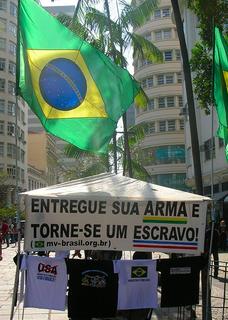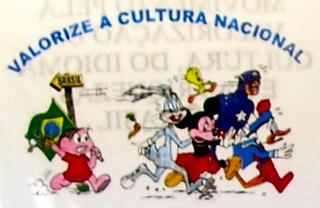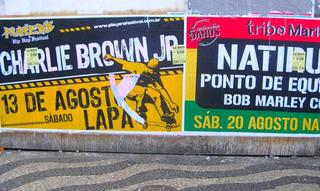A Visit to Centro
Heading for Centro (downtown) from where I am staying in Jardim Botânico, I jumped on the first bus that approached, even though I had never taken this one before. It was the 409 Express and its sign said it would go via the Tunel Rebouças to its destination, which I believe is Saens Peña (I love the name, but have no idea where that is in this sprawling metropolis). I asked the ticket-taker if the bus passed through Centro--the regular 409, which I had taken before, goes through Lapa, just a couple of blocks shy of Rio Branco, the "5th Avenue" of downtown Rio. He said "no" but that I could get a metro at Estacio. nIt was midday, traffic wasn't bad, and the bus made it to Estacio in about 20 minutes (it gets there via Tijuca). Getting the metro (Linea 1) to Carioca station added just ten minutes to the trip (the trains are frequent); this was a good alternative route to downtown.
 At Carioca--in the heart of downtown Rio--onthe finds oneself in a vibrant city, a real city. Much of Rio spreads out along the beach, or in the vast expanse of the Zona Norte, largely residential and definitely not where most tourists want to wander. Many of the famous neighborhoods, such as Ipanema, Leblon, or Copacabana, feel like isolated, smaller cities. Although they have their own points of interest, it is a long and not terribly interesting haul to walk through these, more than a little. You certainly can't walk the city from one neighborhood to another, as one does Paris or Rome or New York. But in downtown, the walking is good. Centro is crowded and busy, and has the things a big city is expected to offer, in a fairly broad and interesting space...beautiful architecture, some new, but much dating to the late 19th and early 20th century (and some older); interesting book stores and music stores; special streets specializing in particular kinds of goods, such as antiques or artisanal woodwork; restaurants and cafés and juice bars; pleasant squares with trees; open air fairs; museums; and millions of interesting faces passing by.
At Carioca--in the heart of downtown Rio--onthe finds oneself in a vibrant city, a real city. Much of Rio spreads out along the beach, or in the vast expanse of the Zona Norte, largely residential and definitely not where most tourists want to wander. Many of the famous neighborhoods, such as Ipanema, Leblon, or Copacabana, feel like isolated, smaller cities. Although they have their own points of interest, it is a long and not terribly interesting haul to walk through these, more than a little. You certainly can't walk the city from one neighborhood to another, as one does Paris or Rome or New York. But in downtown, the walking is good. Centro is crowded and busy, and has the things a big city is expected to offer, in a fairly broad and interesting space...beautiful architecture, some new, but much dating to the late 19th and early 20th century (and some older); interesting book stores and music stores; special streets specializing in particular kinds of goods, such as antiques or artisanal woodwork; restaurants and cafés and juice bars; pleasant squares with trees; open air fairs; museums; and millions of interesting faces passing by.There was not much music in the air today. Sometimes one hears some Andean musicians down from Bolivia or Ecuador playing their quenas and charangos. Today, I only recall hearing the strains of an old Stevie Wonder tune on a synthesizer--the saccharine "I just called to say I love you." This tune was in definite counterpoint to the protest, just half a city block away, against American (North and specifically USA "Anglo" American) culture. I came across two stands promoting a movement dubbed "mv-brasil", one on the pedestrian mall at Rua Uruguaiana (in Carioca) and one in Cinelândia, on the large concrete island standing between the Teatro Municipal, the Biblioteca Nacional, and another grand fin-de-siècle building that houses the municipal government (that is the way it might politely be described; cariocas have other names for it). Cinelândia is perhaps the most impressive architectural space in Centro, and looks much the same as one can see it (very briefly, in stock footage) in Hitchcock's Notorious, from the mid-1940s.
 On the left you can see a photo of the mv-brasil stand on Uruguiana. I like this photo because you can appreciate the beautiful Brazilian flag (pardon the Z, por favor!). You can also see MV's website address so that you can learn of his protest (I am assuming it is a "he" behind this, but I don't know for a fact). In the banner "entregue sua arma" you can see that one of mv's main issues is rallying support against a bill currently in the Brazilian congress, that would ban or limit ownership of arms by average citizens ("Turn in your arms--and turn into a slave!"). The word on the street is that, by contrast with the US, average citizens in Brazil are not highly armed, although organized crime as well as petty criminals are armed to the teeth. Some blame this bill on the anti-gun lobby in the US and its imitators (a complementary argument would be that MV is a front for the American NRA). This is, of course, only one of a laundry list of complaints against the US that one comes across here, as one does in many parts of the Latin world. If you look carefully at the photo, you can also see a t-shirt with the letters "USA" covered by a large red X. MV also has a T-shirt protesting the use of English words in the place of Portuguese--for example, using "diet" instead of "dietético". This recalls similar linguistic nationalism, most famously of the French.
On the left you can see a photo of the mv-brasil stand on Uruguiana. I like this photo because you can appreciate the beautiful Brazilian flag (pardon the Z, por favor!). You can also see MV's website address so that you can learn of his protest (I am assuming it is a "he" behind this, but I don't know for a fact). In the banner "entregue sua arma" you can see that one of mv's main issues is rallying support against a bill currently in the Brazilian congress, that would ban or limit ownership of arms by average citizens ("Turn in your arms--and turn into a slave!"). The word on the street is that, by contrast with the US, average citizens in Brazil are not highly armed, although organized crime as well as petty criminals are armed to the teeth. Some blame this bill on the anti-gun lobby in the US and its imitators (a complementary argument would be that MV is a front for the American NRA). This is, of course, only one of a laundry list of complaints against the US that one comes across here, as one does in many parts of the Latin world. If you look carefully at the photo, you can also see a t-shirt with the letters "USA" covered by a large red X. MV also has a T-shirt protesting the use of English words in the place of Portuguese--for example, using "diet" instead of "dietético". This recalls similar linguistic nationalism, most famously of the French.  But my favorite T-shirt (although I don't necessarily agree with the sentiments expressed), is the one showing the little girl Mônica--one of Brazil's most famous comic-book characters--carrying a Brazilian flag and chasing a horde of cartoon characters from the North American imagination away from "Brasil" (which even in Brazil, up to the late 19th century, was spelled with a z). English speakers can conveniently read the heading on the t-shirt, "Valorize a cultura nacional," without the burden of translation. This is of course ironic. Should it perhaps be the English-speakers of the world who should rise up against the centuries-old infiltration of Latin in their tongue? Our dictionnaries would be half as heavy, and half as expensive.
But my favorite T-shirt (although I don't necessarily agree with the sentiments expressed), is the one showing the little girl Mônica--one of Brazil's most famous comic-book characters--carrying a Brazilian flag and chasing a horde of cartoon characters from the North American imagination away from "Brasil" (which even in Brazil, up to the late 19th century, was spelled with a z). English speakers can conveniently read the heading on the t-shirt, "Valorize a cultura nacional," without the burden of translation. This is of course ironic. Should it perhaps be the English-speakers of the world who should rise up against the centuries-old infiltration of Latin in their tongue? Our dictionnaries would be half as heavy, and half as expensive.Ah, I should be talking about music, as that is my special field. Truthfully, the music in the air in Rio de Janeiro is mainly the Foley stage of urban life, accompanied by its Foley smells. These are dominated by the sounds and smells of autodom: the rattles, roars, whooshes, grumbles, honks, whirrs of cars, buses, trucks, and motorbikes, and the attendant smell of petrol that accompanies them (not only in Rio of course, but in so many large cities in the world; the oil-driven car is the plague of the modern city, isn't it?)
 Apart from the Symphonie mécanique à gasoline, music is apparent in the posters that advertise upcoming public concerts. These are in fair abundance around town. The very large posters plastered on the walls in Cinelândia, at its beginning, where the Cinema Odeon on one side faces a great traffic convergence that leads to a view of the great Guanabara Bay, announce shows directed at a modern, youthful audience, for Brazilian groups playing in rock/soul/funk, hip-hop, DJ-electronica-dance, and reggae styles: Barão Vermelha (rock), Charlie Brown Jr. (a kind of young Brazilian James Brown) Gabriel o Pensador (a very interesting carioca exponent of hip-hop in Brazilian Portuguese), and the Tribo Marley (reggae).
Apart from the Symphonie mécanique à gasoline, music is apparent in the posters that advertise upcoming public concerts. These are in fair abundance around town. The very large posters plastered on the walls in Cinelândia, at its beginning, where the Cinema Odeon on one side faces a great traffic convergence that leads to a view of the great Guanabara Bay, announce shows directed at a modern, youthful audience, for Brazilian groups playing in rock/soul/funk, hip-hop, DJ-electronica-dance, and reggae styles: Barão Vermelha (rock), Charlie Brown Jr. (a kind of young Brazilian James Brown) Gabriel o Pensador (a very interesting carioca exponent of hip-hop in Brazilian Portuguese), and the Tribo Marley (reggae).  One poster announces what is apparently "dance music", because of the terms "DJ" and "80's"--but to find out about this I accessed Google, where we learn that "PLOC 80's" is the "maior festa 80s do Brasil" ("the biggest 80s dance music festival in Brazil"--check out www.ploc80s.com.br/). That is interesting. Just before seeing this sign I had met with a colleague and friend, one of Brazil's leading ethnomusicologists, at the Cinema Odeon café. In our conversation, we touched upon the popularity of dance music. He said that contemporary dance / DJ concerts (he referred in particular to a show by Fatboy Slim) have attracted crowds as large 200,000 here in Rio. This number suggested a rivalry in popularity with samba. We talked about how styles change with the generations, and how the content and meaning of any particular style, and the terms used to describe it, also change. He has been working on projects with what Americans might call "inner city" youth communities, and he said that it was fascinating to learn their perspectives on "samba," which were significantly different from concepts he had grown up with. I will leave it at that, in the hopes that he will publish on this fascinating subject.
One poster announces what is apparently "dance music", because of the terms "DJ" and "80's"--but to find out about this I accessed Google, where we learn that "PLOC 80's" is the "maior festa 80s do Brasil" ("the biggest 80s dance music festival in Brazil"--check out www.ploc80s.com.br/). That is interesting. Just before seeing this sign I had met with a colleague and friend, one of Brazil's leading ethnomusicologists, at the Cinema Odeon café. In our conversation, we touched upon the popularity of dance music. He said that contemporary dance / DJ concerts (he referred in particular to a show by Fatboy Slim) have attracted crowds as large 200,000 here in Rio. This number suggested a rivalry in popularity with samba. We talked about how styles change with the generations, and how the content and meaning of any particular style, and the terms used to describe it, also change. He has been working on projects with what Americans might call "inner city" youth communities, and he said that it was fascinating to learn their perspectives on "samba," which were significantly different from concepts he had grown up with. I will leave it at that, in the hopes that he will publish on this fascinating subject.For the last musical note of this post, I'll mention my visit to the discount CD and DVD section of the Lojas Americanas, branch in Cinelândia. This is a large department store chain, the equivalent to our Woolworths, I think, when Woolworths was something grander than it is today; or perhaps K-mart. There one can pick up CDs for at little at 10 Reais, which at the present exchange rate is slightly more than $4 US dollars, meaning that the CDs are less of a bargain than they were a year ago, when you could buy collections of famous Brazilian MPB musicians--Baden Powell, Elis Regina, Milton Nascimento, etc.--for 8 reais (at the time, around $2.70 US). I picked up two Gilberto Gil CDs, one, the soundtrack to Quilombo, and the other, his album containing the song Palco, a joyous, disco-inflected tune from the late 70s/early 80s. I used to love that one; I'm not sure it would have the same affect on me today. I also bought a collection of works by Egberto Gismonti, one of Brazil's great and fascinating guitarist/composers of the past 30 years. As a final comment, I have noticed that the musical DVD has grown tremendously in importance over the past 2 years or so. DVDs containing music videos, or filmed versions of concerts, are now taking up a considerably larger space in Brazilian music stores compared to 2 years ago (when, I believe, they were insignificant). The newspaper Globo is currently beginning to offer musical DVDs together with their Sunday newspaper, for an extra fee (for a total of 12,90 instead of 3,50, you take the DVD and the newspaper). The first in the series was a DVD concert by Zeca Pagodinho, a popular exponent of the samba-pagode, a style considered "traditional", and certainly very popular among working class audiences in Rio de Janeiro. It is a song style in which vocals and thoughtful lyrics take center stage, but accompanied by a lively assortment of harmonic and percussive instruments, notably the cavaquinho (a relative of the ukulele) and the diverse battery of percussion used for samba. The DVD was sold out at many of the bancas when I checked late on Sunday, but it was still available in Centro. I think I'll have to get it.

2 Comments:
Damn, your going to be good at this blogging thing. Like Meg, I really enjoyed the quick trip to Rio's streets.
A blog can be a noisome thing. Crying to be written. More, more, more.
Post a Comment
<< Home